April 9, 2007 — This week's DaDane
concludes Zeli Schulte's educational, and often emotional, article
about her experiences with canine hemangiosarcoma. For most of us this hasn't
been an "easy read." Today's installment — Zeli's final
installment — will surely be the hardest yet. But Zeli offers a great
deal of insight and some very valuable advice, so please stay with us:
Considering Chemotherapy
The vets at Texas A&M
told us that Grendel might live as long as 2 or 3 months, or as short as
10 days, before the cancer reappeared. They pointed out that although chemotherapy
might prolong Grendel's life, hemangiosarcoma is generally unresponsive
to chemotherapy. Only 30% of those affected might derive some benefit from chemo;
the rest will not. Our treating vet offered even lower numbers.
The discouraging
statistics, coupled with the potential stress of the actual treatment itself,
put us off. We decided to forgo chemo. Instead, we hoped that Grendel would be
one of the lucky ones to beat the odds and become a long-term survivor. Her luck
had held while she was bleeding out on the operating table, so we remained
optimistic.
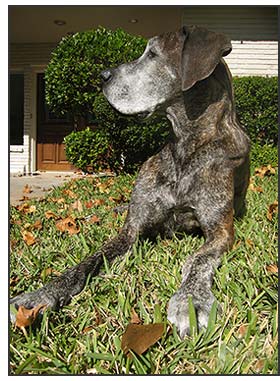 Still,
the vets reminded us that it was not a question of if Grendel's
cancer would come back, but when. Hemangiosarcoma is highly metastic
and it was probably already present in Grendel's other organs. We were told that
as the cancer progressed, at some point there would be another rupture accompanied
by uncontrolled internal bleeding. Grendel would go into shock, and then lose
consciousness. Thankfully, it would be a quick and relatively painless death.
Still,
the vets reminded us that it was not a question of if Grendel's
cancer would come back, but when. Hemangiosarcoma is highly metastic
and it was probably already present in Grendel's other organs. We were told that
as the cancer progressed, at some point there would be another rupture accompanied
by uncontrolled internal bleeding. Grendel would go into shock, and then lose
consciousness. Thankfully, it would be a quick and relatively painless death.
We discussed options with our
treating vet regarding what to do when the time came. We hoped a mobile vet
would be available to come to the house to put Grendel down. We also discussed
drugs that might be utilized to ease Grendel's anxiety, especially if no mobile
vet was readily available.
Life Goes
On — Or does It?
Meanwhile,
with Grendel doing so well five weeks out, I lapsed into a false sense of security.
I began to believe she was bullet-proof and that she might exceed our most optimistic
expectations. Her incision had healed. She was no longer on pain meds or antibiotics.
She was stronger. We were able to take longer walks. I was getting up with her
less often during the night. I started making plans to take Grendel swimming
at the Lakes as soon as spring came.
Then,
on January 26, 2007, Grendel woke me up six times during the night. She just
could not get comfortable. I gave her some Tramadol to help her settle down.
The following morning, to keep her comfortable, we continued with the Tramadol.
The fact that Grendel was still eating reassured me, but the following night
she refused her dog food. She did, however, eat some steak and grilled liver.
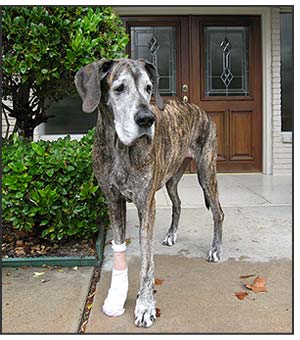 I thought she was simply being finicky and I relished the opportunity to spoil
her. We figured that as long as Grendel was enjoying her walks and continuing
to eat, this was just a bump in the road.
I thought she was simply being finicky and I relished the opportunity to spoil
her. We figured that as long as Grendel was enjoying her walks and continuing
to eat, this was just a bump in the road.
Once again, I had
dismissed the warning signs.
Two nights later
when I got Grendel up to take her outside before going to bed, she had a very
difficult time getting to her feet and walking outside. Once she was back inside
it took her a long time to get comfortable, despite a recent dose of Tramadol.
I gave her some more Tramadol so that she could sleep comfortably and waited
for what the morning would bring.
Time to Say Goodbye
When
morning came, Grendel seemed relaxed on her bed as she awoke. She stretched and
licked my face when I petted her, but as soon as she tried to stand up, she was
in a lot of pain. She was stiff, panted heavily, and stumbled as she walked outside.
She had a particularly hard time getting into position to urinate. We immediately
realized that we had a very short time to make a decision before she would need
to relieve herself again. Given the amount of pain Grendel was experiencing,
I could not ask her to get up any more. We had fought the good fight. I knew
we had done everything that we could for Grendel, and that her last days had
been filled with good times and the certain knowledge, daily expressed, that
she was loved.
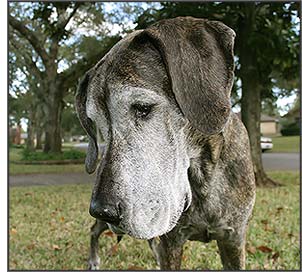 Our only surprise
was Grendel's obvious pain. We had been told that her death would be painless,
that Grendel would simply lose consciousness. This was clearly not the case.
The cancer would not loosen its grip on Grendel so easily.
Our only surprise
was Grendel's obvious pain. We had been told that her death would be painless,
that Grendel would simply lose consciousness. This was clearly not the case.
The cancer would not loosen its grip on Grendel so easily.
Fortunately,
we had the Tramadol and Valium that our treating vet had prescribed as a last
resort. It was time to use it. Within a half an hour we noticed that Grendel
was relaxing, and licking her paw like she usually did. She kissed my face when
I kneeled down to pet her. As I lay on the couch next to her bed, Grendel eased
herself onto her side and went to sleep. She remained asleep when the vet came
to administer the sedative and lethal injection.
Final Thoughts
After all we went through, would I ever do this again? Would
I recommend this surgery to anybody? Decisions following diagnosis of hemangiosarcoma
are far from easy — and they are very personal. In my case, the decision
to proceed with surgery came down to three factors:
The Cost — would
we be able to handle the cost of surgery & post-surgical
treatment?
The Dog — would
Grendel's age and any health issues make surgery unfeasible?
The Owner — would
I be able to meet the many commitments required to care for a terminally ill
dog? Moreover, would I have the emotional resilience to continue or discontinue
treatment, and then to ultimately make the decision to put Grendel down if the
surgery or post-surgical recovery did not go well?
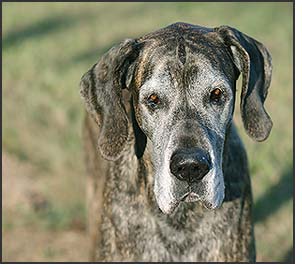 Grendel's surgery was over $4,800;
her daily blood transfusions were $1,500 per day. Fortunately, she was
in good shape at 9.5 years so that she was able to survive surgery and post-surgery.
(By contrast, our other Dane, Grimm, would never be a good candidate for this
type of surgery given his Wobblers, cardiac and kidney problems.) Because we
are self-employed, Bret and I had the ability to adjust
our work schedules to Grendel's needs. In that regard, we were extremely fortunately.
Still, it wasn't very easy to go to work after getting up with Grendel 2-9
times each night. Beyond that, you have to be able to "be there" emotionally
for your dog. No
matter how dark things looked in the ICU, we always made an effort to be upbeat
when visiting Grendel as well as upbeat in our interactions with the vets, so
they would not give up on her.
Grendel's surgery was over $4,800;
her daily blood transfusions were $1,500 per day. Fortunately, she was
in good shape at 9.5 years so that she was able to survive surgery and post-surgery.
(By contrast, our other Dane, Grimm, would never be a good candidate for this
type of surgery given his Wobblers, cardiac and kidney problems.) Because we
are self-employed, Bret and I had the ability to adjust
our work schedules to Grendel's needs. In that regard, we were extremely fortunately.
Still, it wasn't very easy to go to work after getting up with Grendel 2-9
times each night. Beyond that, you have to be able to "be there" emotionally
for your dog. No
matter how dark things looked in the ICU, we always made an effort to be upbeat
when visiting Grendel as well as upbeat in our interactions with the vets, so
they would not give up on her.
And then there's one
final consideration: Surgery for hemangiosarcoma, in contrast to other cancers, will
prolong your dog's
life for only a short time. If surgery does not improve your dog's life, will
simply prolonging your dog's life for a few months, or even for a matter
of days, be enough for you? More importantly, would it be in your dog's
best interest? At what point might treatment cause more trauma than relief?
You
have to constantly reassess your motives and ask yourself if you are doing right
by your dog or just holding on because you can't bear to say goodbye.
I strongly believe that Grendel — regardless of her surgical complications —
had a very good last month with us. Even in her last hours, I was contemplating
another surgery even though, realistically, I knew that could never be an option. I somehow thought I could keep
Grendel alive because I wouldn't accept the possibility that she was going to
die.
Finally, and perhaps most importantly,
you must have the emotional resilience to be able to face facts, change gears
and ultimately let go.
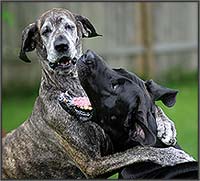
— ENDNOTES —
Do you recall the A&M vet student who cried as she watched us with Grendel
during that first visit together in the ICU? Later, after learning of Grendel’s
passing, she shared the following with me:
Although the time I spent with Grendel was very little, I could certainly
see that she was a fighter and a very special dog. Her love for her family was
incredibly evident. She would always brighten up so much when you came to see
her, and it seems to me that much of her will to fight must have come from how
much she was loved.
I think Grendel fought so hard because she wanted to
stay with us — her family — as long as she could.
A
few days after Grendel passed, Bret revealed to me something that happened while
Grendel was in surgery. He had received a call from the surgical assistant informing
him that the surgeons were unable to stop the bleeding. They wanted permission
to put Grendel down while she was still under anesthesia. After the call,
assuming Grendel was gone, Bret got into the car and began the sad drive to Texas
A&M
to collect her remains. Ten minutes into the trip
he received another call from A&M.
They were letting him know that the bleeding had suddenly stopped and the surgeons
were proceeding with the operation.
When Bret told me that,
I realized once again how truly lucky we were. Even in our misfortune, we were
fortunate that Grendel — at
her age and given the surgical complications — was able to survive the
surgery and battle her way through post-surgery recovery like she did. Grendel's
fight for life and her struggle to return home to us will always be an inspiration. |
|

![]()



 Still,
the vets reminded us that it was not a question of if Grendel's
cancer would come back, but when. Hemangiosarcoma is highly metastic
and it was probably already present in Grendel's other organs. We were told that
as the cancer progressed, at some point there would be another rupture accompanied
by uncontrolled internal bleeding. Grendel would go into shock, and then lose
consciousness. Thankfully, it would be a quick and relatively painless death.
Still,
the vets reminded us that it was not a question of if Grendel's
cancer would come back, but when. Hemangiosarcoma is highly metastic
and it was probably already present in Grendel's other organs. We were told that
as the cancer progressed, at some point there would be another rupture accompanied
by uncontrolled internal bleeding. Grendel would go into shock, and then lose
consciousness. Thankfully, it would be a quick and relatively painless death.
 I thought she was simply being finicky and I relished the opportunity to spoil
her. We figured that as long as Grendel was enjoying her walks and continuing
to eat, this was just a bump in the road.
I thought she was simply being finicky and I relished the opportunity to spoil
her. We figured that as long as Grendel was enjoying her walks and continuing
to eat, this was just a bump in the road. Our only surprise
was Grendel's obvious pain. We had been told that her death would be painless,
that Grendel would simply lose consciousness. This was clearly not the case.
The cancer would not loosen its grip on Grendel so easily.
Our only surprise
was Grendel's obvious pain. We had been told that her death would be painless,
that Grendel would simply lose consciousness. This was clearly not the case.
The cancer would not loosen its grip on Grendel so easily. Grendel's surgery was over $4,800;
her daily blood transfusions were $1,500 per day. Fortunately, she was
in good shape at 9.5 years so that she was able to survive surgery and post-surgery.
(By contrast, our other Dane, Grimm, would never be a good candidate for this
type of surgery given his Wobblers, cardiac and kidney problems.) Because we
are self-employed, Bret and I had the ability to adjust
our work schedules to Grendel's needs. In that regard, we were extremely fortunately.
Still, it wasn't very easy to go to work after getting up with Grendel 2-9
times each night. Beyond that, you have to be able to "be there" emotionally
for your dog. No
matter how dark things looked in the ICU, we always made an effort to be upbeat
when visiting Grendel as well as upbeat in our interactions with the vets, so
they would not give up on her.
Grendel's surgery was over $4,800;
her daily blood transfusions were $1,500 per day. Fortunately, she was
in good shape at 9.5 years so that she was able to survive surgery and post-surgery.
(By contrast, our other Dane, Grimm, would never be a good candidate for this
type of surgery given his Wobblers, cardiac and kidney problems.) Because we
are self-employed, Bret and I had the ability to adjust
our work schedules to Grendel's needs. In that regard, we were extremely fortunately.
Still, it wasn't very easy to go to work after getting up with Grendel 2-9
times each night. Beyond that, you have to be able to "be there" emotionally
for your dog. No
matter how dark things looked in the ICU, we always made an effort to be upbeat
when visiting Grendel as well as upbeat in our interactions with the vets, so
they would not give up on her. 
